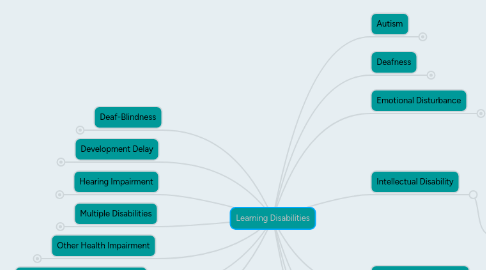Learning Disabilities
da Ellen Concepcion


1. Deaf-Blindness
1.1. Hearing and visual impairments, causing severe communication and other developmental and educational needs that they cannot be accommodated in special education programs solely for children with deafness or children with blindness. Assistive technologies include computer activities designed to support communication including: the teaching of cause-and-effect relationships, early language development activities such as symbol recognition, choice making, requesting, and labeling continued language development and expansion. Links to the National Center on Deaf and Blindness.
2. Development Delay
2.1. A delay in physical or cognitive development, communication, social or emotional development, or behavior development. Links to resources for teachers and parents with students that have developmental delays.
3. Hearing Impairment
3.1. An impairment in hearing, that adversely affects a child’s educational performance but is not included under the definition of “deafness.” Assistive technologies include assisted listening devices.
4. Multiple Disabilities
4.1. the combination of disabilities that cannot be accommodated in a special education program solely for one of the impairments. The term does not include deaf-blindness. Assistive technologies could include assisted living tools, like joy sticks, mouth sticks and trackballs.
5. Other Health Impairment
5.1. Limited strength, vitality, or alertness, including a heightened alertness to environmental stimuli, that results in limited alertness with respect to the educational environment, that— (a) is due to chronic or acute health problems such as asthma, attention deficit disorder or attention deficit hyperactivity disorder, diabetes, epilepsy, a heart condition, hemophilia, lead poisoning, leukemia, nephritis, rheumatic fever, sickle cell anemia, and Tourette syndrome; and (b) adversely affects a child’s educational performance.
5.1.1. Adaptive technologies include word prediction software, speech-to-text apps and games to help with memory. One student at our local high school has notes written for her so she doesn't have to copy them off the smart board. Something like Dragon Dictation, which helps record voice to text, could be used to help her without her feeling as if she needs to rely on someone else. Appropriate technologies can and should be used to help empower students by helping them help themselves.
6. Speech or Language Impairment
6.1. A communication disorder such as stuttering, impaired articulation, a language impairment, or a voice impairment that adversely affects a child’s educational performance. Speech assist technologies could be used such as word predictor software.
7. Visual Impairment Including Blindness
7.1. An impairment in vision that, even with correction, adversely affects a child’s educational performance. The term includes both partial sight and blindness. Adaptive technologies include Braille embossers that transfer computer generated text into embossed Braille output. Link takes you to Microsoft assistive technology products.
8. Autism
8.1. Assistive Technology Resources
8.2. Autism Spectrum Disorder Video
8.3. a developmental disability significantly affecting verbal and nonverbal communication and social interaction, generally evident before age three, that adversely affects a child’s educational performance.
9. Deafness
9.1. a hearing impairment so severe that a child is impaired in processing linguistic information through hearing, with or without amplification. Assistive technologies include caption and sub-title supported media software players and Real-Time Text (RTT) Software.
9.1.1. Untitled
10. Emotional Disturbance
10.1. A condition including characteristics that impact a student's capacity to learn, including inappropriate behavior, unhappiness or depression, schizophrenia or other emotional disturbance. "AT tools. Four specific tools may be used by both teachers and students to assist them with the task of monitoring behavior during assigned classroom tasks. These include (a) stop watches, (b) hand-held counters, (c) Palm devices, and (d) computer devices." (Parette, Crowley, & Wojcik, 2007) Tools should be used as an intervention that reduces triggers to undesirable behaviors, they should also not draw any extra attention to the student. Resource Parette, H. P., Jr., Crowley, E. P., & Wojcik, B. W. (2007, September). Reducing overload in students with learning and behavioral disorders: The role of assistive technology. Retrieved from http://www.academia.edu/2890752/Reducing_overload_in_students_with_learning_and_behavioral_disorders_The_role_of_assistive_technology
11. Intellectual Disability
11.1. “Intellectual Disability” is a new term in IDEA. Until October 2010, the law used the term “mental retardation.” In October 2010, Rosa’s Law was signed into law by President Obama. Rosa’s Law changed the term to be used in future to “intellectual disability.” The definition of the term itself did not change and is what has just been shown above. Assistive technologies include abbreviation expanders, electronic worksheets, optical character recognition and talking calculators. Link takes you to a Great Schools.org article discussing tools more in-depth.
12. Orthopedic Impairment
12.1. A severe orthopedic impairment that adversely affects a child’s educational performance. Link to a video about an amazing technology that helps a student communicate.
12.1.1. Assistive Technology in Action - Meet Elle
